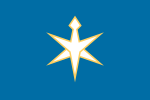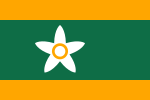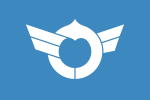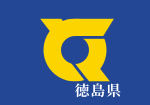Flags of Japanese prefectures
This article needs additional citations for verification. (July 2024) |
You can help expand this article with text translated from the corresponding article in Japanese. (May 2022) Click [show] for important translation instructions.
|
Each modern Japanese prefecture has a unique flag, most often a bicolour geometric highly stylised design, often incorporating the characters of the Japanese writing system and resembling minimalistic company logos.[1] The heraldic badges worn by warriors in medieval Japan (mon) were forerunners of the modern emblems used in the prefectural flags.[2]
A distinct feature of these flags is that they use a palette of colours not usually found in flags, including orange, purple, aquamarine and brown.
Some prefectures also have alternative official flags called "symbol flags" (シンボル旗). They may be used on less formal occasions. Famous symbol flags include the one used in Tokyo.
Flags by prefecture
[edit]| Flag | Prefecture | Geocode | Date of adoption | Description |
|---|---|---|---|---|
 | Aichi | JP-23 | August 15, 1950 | Stylised hiragana of the あ in あいち (Aichi). The emblem also expresses sunrise and wave to indicate Aichi's location facing the Pacific Ocean. |
 | Akita | JP-05 | November 3, 1959 | |
 | Aomori | JP-02 | January 1, 1961 | Stylised map of the prefecture. |
 | Chiba | JP-12 | July 29, 1963 | |
 | Ehime | JP-38 | May 5, 1952 | |
 | Fukui | JP-18 | March 28, 1952 | |
 | Fukuoka | JP-40 | May 10, 1966 | |
 | Fukushima | JP-07 | October 23, 1968 | |
 | Gifu | JP-21 | August 10, 1932 | |
 | Gunma | JP-10 | October 25, 1968 | |
 | Hiroshima | JP-34 | July 23, 1966 | |
 | Hokkaidō | JP-01 | May 1, 1967 | |
 | Hyōgo | JP-28 | June 10, 1964 | |
 | Ibaraki | JP-08 | November 13, 1991 | |
 | Ishikawa | JP-17 | October 1, 1972 | Stylised kanji of 石川. |
 | Iwate (detail) | JP-03 | March 6, 1965 | |
 | Kagawa | JP-37 | October 1, 1977 | |
 | Kagoshima (detail) | JP-46 | March 10, 1967 | |
 | Kanagawa | JP-14 | November 4, 1948 | |
 | Kōchi | JP-39 | April 15, 1953 | |
 | Kumamoto | JP-43 | March 31, 1966 | |
 | Kyoto | JP-26 | November 2, 1976 | |
 | Mie | JP-24 | April 20, 1964 | |
 | Miyagi | JP-04 | July 15, 1966 | |
 | Miyazaki | JP-45 | December 22, 1964 | |
 | Nagano | JP-20 | March 20, 1967 | |
 | Nagasaki | JP-42 | August 30, 1991 | |
 | Nara | JP-29 | March 1, 1968 | |
 | Niigata | JP-15 | August 23, 1968 | |
  | Ōita | JP-44 | July 24, 1966 | |
 | Okayama | JP-33 | November 22, 1967 | |
 | Okinawa (detail) | JP-47 | October 13, 1972 | |
 | Ōsaka | JP-27 | June 21, 1968 | |
 | Saga | JP-41 | December 11, 1968 | |
 | Saitama | JP-11 | September 1, 1964 | |
 | Shiga | JP-25 | September 16, 1968 | |
 | Shimane | JP-32 | November 8, 1968 | |
 | Shizuoka | JP-22 | August 26, 1968 | |
 | Tochigi | JP-09 | March 1, 1964 | |
  | Tokushima | JP-36 | March 18, 1966 | |
 | Tokyo (detail) | JP-13 | October 1, 1964 | A six-rayed stylised sun with a dot in the center. The background color is Edo purple (江戸紫, Edo murasaki), which was popular in Edo, the name of Tokyo during the Edo period. This shade of purple is one of the traditional colors of Japan, and is near identical to Web Indigo. |
 | September 30, 1989 | A stylised vivid green Ginkgo biloba leaf. The symbol consists of three arcs combined to resemble a leaf of the ginkgo, the metropolitan tree, and represents T for Tokyo. Created by Rei Yoshimura (レイ吉村), a professional graphic designer. | ||
 | Tottori | JP-31 | October 23, 1968 | |
 | Toyama | JP-16 | December 27, 1988 | |
 | Wakayama | JP-30 | August 7, 1969 | |
 | Yamagata | JP-06 | March 26, 1963 | |
 | Yamaguchi | JP-35 | September 3, 1962 | |
 | Yamanashi | JP-19 | December 1, 1966 |
Symbol mark flag
[edit]- Symbol mark flag of Kagoshima Prefecture
- Symbol mark flag of Tokyo
Historical flags
[edit]- Toyama Prefecture (1957–1988)
- Osaka Prefecture (1968–1984)
- Kumamoto Prefecture (1960)
- Yamagata Prefecture (1963–1971)
- Fukushima Prefecture (1951–1968)
- Ibaraki Prefecture (1966–1991)
- Ehime Prefecture (1989–1999)
- Nagasaki Prefecture (1991, unofficial)
- Okinawa Prefecture (24 April–15 May 1972)
- Okinawa Prefecture (15 May–13 October 1972)
- Karafuto Prefecture (1911–1949)
See also
[edit]References
[edit]- ^ "DESIGN IN FLAGS: THE BEAUTY FOUND IN JAPAN'S FLAGS". DESIGN MADE IN JAPAN. Retrieved July 21, 2024.
- ^ Inglefield, Eric (1984). Flags. Arco Pub. p. 18. ISBN 0-668-06262-2.


 French
French Deutsch
Deutsch











